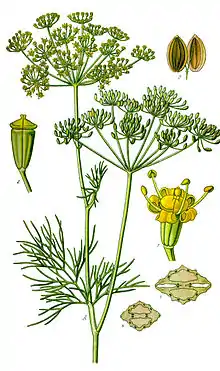| Anethum | |
|---|---|
 | |
| 19th-century botanical illustration of Anethum graveolens[1] | |
| Scientific classification | |
| Kingdom: | Plantae |
| Clade: | Tracheophytes |
| Clade: | Angiosperms |
| Clade: | Eudicots |
| Clade: | Asterids |
| Order: | Apiales |
| Family: | Apiaceae |
| Subfamily: | Apioideae |
| Tribe: | Apieae |
| Genus: | Anethum L. |
| Species | |
| |
Anethum is a flowering plant genus in the family Apiaceae, native to the Middle East and the Sahara in northern Africa.[2]
Taxonomy
The genus name comes from the Latin form of Greek words ἄνῑσον anison, ἄνησον anīson, ἄνηθον anīthon and ἄνητον anīton, which all meant "dill" and "anise";[3] anise is now placed in a different genus named Pimpinella.
Species
There are 4 recognized species in this genus, they are:[2][4]
- Anethum graveolens L. – dill
- Anethum involucratum Korovin
- Anethum patulum L. ex B.D.Jacks.
- Anethum theurkauffii Maire
References
- ↑ Thomé, Otto Wilhelm (1888). Flora von Deutschland, Österreich und der Schweiz (in German). Vol. 3. Gera, Germany. p. 142 – via BioDiversity Heritage Library.
{{cite book}}: CS1 maint: location missing publisher (link) - 1 2 "Anethum L." Plants of the World Online. The Royal Botanic Gardens, Kew. 2023. Retrieved 11 February 2023.
- ↑ Lewis, Charlton T.; Short, Charles (1879). "ănēthum". A Latin Dictionary. Perseus Digital Library.
- ↑ "Anethum L." World Flora Online. World Flora Consortium. 2023. Retrieved 11 February 2023.
This article is issued from Wikipedia. The text is licensed under Creative Commons - Attribution - Sharealike. Additional terms may apply for the media files.